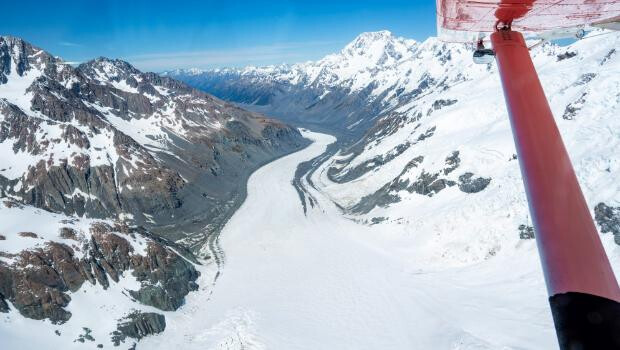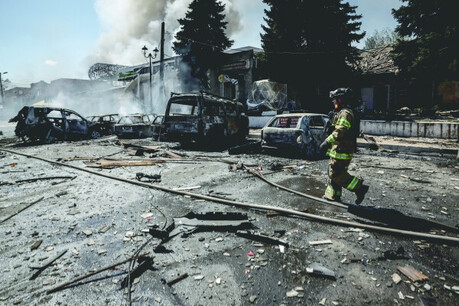
WELLINGTON, NEW ZEALAND – The striking transformation of New Zealand’s Southern Alps into a landscape of red during the summer of 2019-2020, initially speculated to be the fallout of Australia’s devastating bushfires, has been definitively linked to a massive trans-Tasman dust storm. Groundbreaking research, published in the journal Geophysical Research Letters in December of last year, unveils that approximately 4,500 tons of vivid red dust, originating from southeast Australia, blanketed the pristine white snow, delivering a visual spectacle with significant environmental implications.
The study, spearheaded by Dr. Holly Winton, an environmental scientist at Te Herenga Waka—Victoria University of Wellington, employed a multi-pronged approach to unravel the mystery of the crimson peaks. By meticulously analyzing time-lapse imagery, reconstructing atmospheric pathways through air mass back trajectory modeling, conducting detailed geochemical analyses of snow impurities, and utilizing remote sensing data, the researchers established a clear timeline and origin for the unusual coloration. Their findings conclusively demonstrate that the red dust arrived in the Southern Alps in late November 2019, well before the peak intensity of the Australian bushfires that raged around the New Year of 2020.
“Media reports in 2020 generally assumed the blanket of red on the mountains was caused by ash swept across the sea from Australia’s devastating New Year bushfires,” Dr. Winton explained. “But the red dust that led to the dramatic colour change actually arrived well before New Year.”
Meteorological Conditions Align for Dust Transport
The colossal dust storm that swept across southeast Australia in late November 2019 was fueled by a specific set of meteorological conditions. Persistent westerly and southwesterly winds, associated with a strong frontal system, lifted vast quantities of dust from the arid and semi-arid regions of the continent’s interior. These powerful air currents then carried the suspended particles eastward across the Tasman Sea, a journey of over 2,000 kilometers, before depositing their dusty cargo onto the elevated terrain of New Zealand’s South Island. While a significant dust storm had also occurred in February 2019 in central and eastern Australia, with evidence of long-range transport to New Zealand and even Antarctica, the November event proved to be the primary contributor to the dramatic red hue observed on the Southern Alps.
Geochemical Fingerprint Points to Australian Origin
The geochemical analysis of the red impurities found in the snow samples from the Fox, Franz Josef, and Tasman glaciers provided crucial evidence linking the contamination to southeast Australia. The distinct mineral composition and elemental ratios within the dust particles acted as a unique fingerprint, matching the signature of soils and dust sources in the identified region of Australia. This analysis effectively ruled out volcanic ash or other local sources of discoloration. The dominant component of the deposited material was identified as mineral dust, with a mean dust mass concentration of 6.5 ± 0.7 grams per square meter across the affected area.
Accelerated Snow and Ice Melt: A Climate Change Warning
The deposition of this substantial layer of red dust had a significant impact on the reflective properties of the snowpack. Pure white snow boasts a high albedo, meaning it reflects a large percentage of incoming solar radiation back into the atmosphere. However, the dark red dust particles absorbed more sunlight, reducing the snow’s albedo. This increased absorption of solar energy led to a rise in surface temperatures, subsequently accelerating the melting of snow and ice in the already vulnerable alpine environment. Studies have shown that even small concentrations of dust in snow can significantly reduce albedo and enhance snowmelt. The estimated 4,500 tons of dust deposited on the Southern Alps likely triggered a considerable increase in melt rates during the 2019-2020 summer.
Historical Context: Not an Isolated Incident
While the red snow event of 2019-2020 was particularly striking, research indicates that it was not an isolated occurrence. Dr. Phil Novis, a phycologist from Manaaki Whenua Landcare Research and a co-author of the study, noted that this was at least the ninth such event recorded in Aotearoa New Zealand since 1902, emphasizing that the frequency of these dust deposition events underscores a long-term pattern. Earlier research examining dust deposition in alpine lakes in Kahurangi National Park revealed an increase in dust deposition in New Zealand during the 20th century, peaking between the 1920s and 1990s, which correlated with land use changes in Australia.
Climate Change Amplifying Dust Storms and Wildfires
The researchers warn that the confluence of conditions leading to the red snow event – a massive Australian dust storm and subsequent snowmelt coinciding with bushfire smoke – could become more frequent under a changing climate. Climate change models predict increased desertification and drier conditions in many parts of Australia, making the continent more susceptible to large-scale dust storms. These same dry and hot conditions also exacerbate the risk and intensity of bushfires. The meteorological patterns that trigger dust storms, such as strong winds associated with frontal systems, can also contribute to the spread of wildfires.
Broader Environmental Consequences
The increased deposition of dust on glaciers and snowfields has far-reaching environmental consequences. Accelerated snow and ice melt contributes to sea-level rise and alters hydrological regimes, impacting water resources for downstream ecosystems and human populations. Changes in snowpack dynamics can also affect alpine ecosystems, influencing vegetation patterns and biodiversity. Furthermore, the nutrients contained within the dust can have complex effects on alpine lakes and soils, potentially altering their biogeochemical cycles.
A Red Flag for Climate Action
The dramatic red coloration of New Zealand’s Southern Alps served as a stark visual reminder of the interconnectedness of distant environmental events and the potential for unexpected and significant impacts. This research underscores the need for a comprehensive understanding of the less obvious consequences of climate change. As Dr. Winton concluded, this event should act as a “red flag,” urging leaders and policymakers to account for these complex environmental interactions when formulating climate change mitigation and adaptation strategies. The incident highlights that the impacts of climate change are not confined to rising temperatures and sea levels but extend to atmospheric dust transport and its cascading effects on seemingly remote environments. Addressing the root causes of desertification and extreme weather events in regions like Australia is crucial to protecting vulnerable ecosystems like the Southern Alps from future dramatic transformations.
[Copyright (c) Global Economic Times. All Rights Reserved.]






























